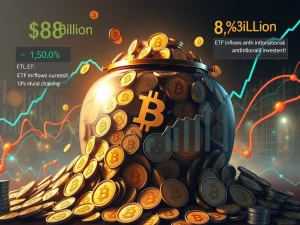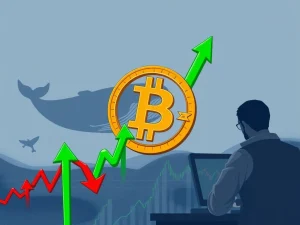Bitcoin Millionaire Myth: The Shocking Reality of a 2010 $1 Investment

The allure of becoming a **Bitcoin millionaire myth** from a tiny initial sum is powerful. Many daydream about stepping into a time machine. They imagine buying a pile of Bitcoin for pennies in 2010. Then, they would return to the present with millions. In March 2010, the first recorded Bitcoin exchange price was about $0.003 per Bitcoin (BTC). Prices never rose above $0.40 that year. Today, BTC trades well into the six-figure range. However, the truth reveals a different story. Becoming a Bitcoin millionaire required much more than just an **early Bitcoin investment**.
Bitcoin Price History: The Volatile Ascent
Bitcoin’s journey from obscurity to six-figure valuations was a series of sharp surges. These were often followed by brutal crashes. Many of these events would have prompted even a sane person to cash out. Consider the rollercoaster ride of its **Bitcoin price history**:
- 2010-2011: In January 2010, $1 could buy about 333 BTC at roughly $0.003 each. By June 2011, Bitcoin peaked at $30. That same stash was worth almost $10,000. Soon after, the price collapsed. The net value of those 333 BTC fell to about $666.
- 2013: The same stack soared to roughly $88,000 at the $266 April high. It then plunged to over $16,500 by summer. By November’s $1,000 peak, your holdings would reach $333,000. This represented significant wealth at the time.
- 2014-2015: The Mt. Gox collapse gutted market confidence. It sent the price to around $150. Your stack fell to almost $50,000. This period tested investor resolve severely.
- 2017-2018: At around $20,000, your initial $1 investment hit $6.66 million. Yet, by the 2018 low, it fell to about $1.13 million. This was still substantial, but it represented a steep drop.
- 2020-2022: COVID-19’s “Black Thursday” halved Bitcoin’s price in two days. The November 2021 all-time high of $69,000 pushed your stack to $22.98 million. Only a year later, it slid to $5.29 million.
- 2024-2025: In March 2024, Bitcoin reached a new all-time high above $73,000. This made your original dollar worth more than $24 million.
Surviving all that volatility required extreme discipline. It demanded enduring euphoria, crashes, and scandals. A critical question remains: Why would you sell now? Unrealized gains in Bitcoin resemble quantum superposition. They only “collapse” into reality when you sell. Until that moment, your millions exist only as numbers on a screen. They remain hostage to Bitcoin’s next move.
Holding Bitcoin Challenges: Surviving Market Shocks
Not all selling pressure came from price drops. Some of Bitcoin’s biggest tests came from news events. These challenged even the most committed hodlers. Truly, the **holding Bitcoin challenges** extended beyond mere price swings. For instance, several major events created immense pressure:
- Exchange Disasters: In 2014, Mt. Gox, then handling over 70% of global Bitcoin trading, revealed it had lost more than 650,000 BTC. Bankruptcy wiped out thousands of early investors. Furthermore, in 2016, the Bitfinex hack saw over 119,000 BTC stolen. It understandably sparked fears of more exchange failures. Many similar examples exist throughout Bitcoin’s history.
- Crime and Stigma: The FBI’s 2013 takedown of Silk Road linked Bitcoin to illegal trade in the public mind. Multimillion-dollar wallet seizures resurfaced for years. This fueled debate over whether Bitcoin was inherently tied to crime. Such perceptions significantly impacted market sentiment.
- Policy Shocks: China repeatedly disrupted markets. This included its 2013 banking ban and 2017 exchange closures. The 2021 announcement made all crypto transactions illegal. Each event sparked fears of wider crypto regulation crackdowns globally.
- Forks: The 2017 blocksize debate, the Bitcoin Cash fork, and the abrupt SegWit2x cancellation divided the community. They raised questions about Bitcoin’s scalability and future direction.
- Industry Implosions: The 2022 FTX collapse, at the time the second-largest crypto exchange, triggered a liquidity crisis. It generated “crypto is dead” headlines across mainstream media. This event severely eroded trust in the broader crypto ecosystem.
Each of these moments forced investors to reconsider. Was holding worth the risk? Even with foresight to buy Bitcoin early and discipline to hold through every market crash, scandal, and policy shift, retaining your coins remained difficult.
Beyond Volatility: The Risk of Lost Bitcoin Keys
You might have also lost access to your investment. Bitcoin ownership is binary. You either control the private keys or you do not. Once they are lost, your fortune is gone. **Lost Bitcoin keys** represent a major factor in the permanent removal of coins from circulation. Chainalysis estimates that 2.3 million to 3.7 million BTC are permanently out of circulation. These coins are locked in wallets with keys that were misplaced, destroyed, or otherwise inaccessible. Many belonged to early adopters. They treated Bitcoin as a curiosity. They stored it on laptops or external drives. These devices were later wiped, recycled, or discarded. This often occurred without a second thought to the digital assets they contained.
One of the most famous examples involves James Howells. This engineer from Newport, Wales, accidentally threw away a hard drive. It contained about 8,000 BTC, now worth hundreds of millions. He has spent years seeking permission to dig through a landfill to recover it. Even diligent holders were not immune. Coins stored on exchanges that later failed, such as Mt. Gox or QuadrigaCX, could disappear overnight. This left “holding” out of the owner’s control. In Bitcoin’s history, the bigger danger often was not selling too soon. Instead, it was losing access completely. This highlights a critical, often overlooked, aspect of crypto ownership.
Debunking the Bitcoin Millionaire Myth: Real-World Scenarios
History shows there are almost no documented cases of the $1-to-Bitcoin-millionaire story by 2025. Instead, real-world examples reflect scenarios that occurred far more often. These stories help to truly debunk the **Bitcoin millionaire myth**.
- Kristoffer Koch: He bought around 5,000 BTC in 2009 for $26.60. He sold 1,000 BTC to buy an apartment. This happened years before Bitcoin’s biggest rallies. He realized significant gains, but not the multi-million dollar fortune from his entire stack.
- Stefan Thomas: He lost access to over 7,000 BTC, worth over $400 million today. This was due to a forgotten password for his IronKey device. His story exemplifies the permanent loss risk.
- The Winklevoss Twins: They became Bitcoin billionaires. However, they achieved this after buying around 70,000 BTC with an $11 million lump sum in 2013. This was long after Bitcoin’s sub-$1 days. Their success came from a substantial, strategic investment.
- Li Xiaolai: He accumulated over 100,000 BTC. He did this by making large purchases in 2011. He did not achieve this with spare change. His story highlights the need for significant capital.
To summarize, Bitcoin fortunes were not made by a casual buy-and-forget strategy with mere pocket money. They came from large early stakes. They required strict security practices. Exceptional discipline was essential. Furthermore, the rare ability to endure both parabolic rises and severe crashes without panic selling proved crucial. That’s why the “time-travel millionaire” idea remains more myth than reality. The number of people who have lived through Bitcoin’s full price history while still holding their original stack is vanishingly small.
The Unlikely Path to Early Bitcoin Investment Success
An **early Bitcoin investment** in 2010 for a single dollar offered incredible potential. However, the path to becoming a millionaire from that investment was fraught with peril. It required a combination of luck, foresight, unwavering conviction, and impeccable security practices. Most early investors either lost their keys, sold during crashes, or capitulated due to FUD (fear, uncertainty, and doubt). The narrative of effortless riches from a minimal investment simply does not align with the complex realities of Bitcoin’s volatile journey. Understanding these challenges provides a more realistic perspective on cryptocurrency investing.










